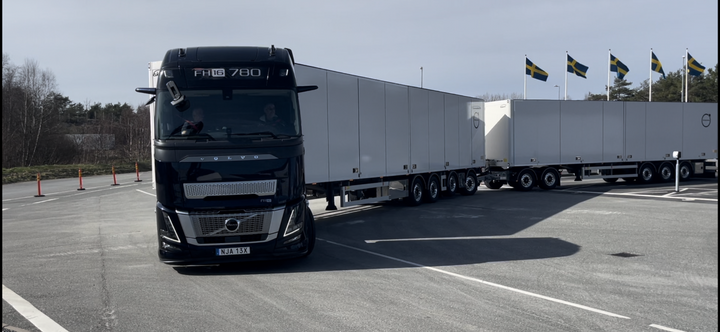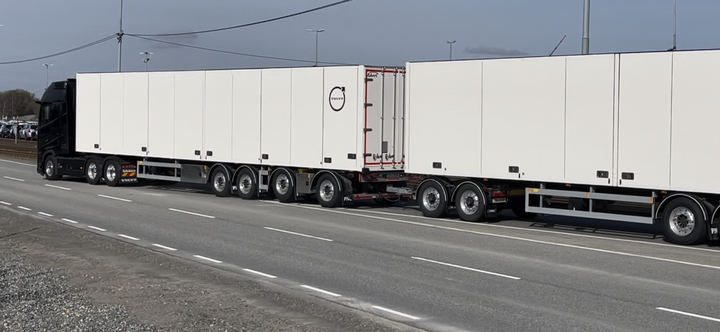Trucker Access › Forums › Diesel News › Trucking and GHG: Emissions Impossible? – Truck Tech
- This topic has 0 replies, 1 voice, and was last updated 11 months ago by
 EazyRiDer66.
EazyRiDer66.
-
AuthorPosts
-
May 6, 2024 at 11:00 pm #18643
 EazyRiDer66Keymaster
EazyRiDer66Keymaster

Sweden now allows 117-foot combination trailers as a means of reducing emissions and freight efficiency. Should we do the same in North America?
In April, on Good Friday, the U.S. Environmental Protection Agency did a classic “news dump” and finally showed us what the 2027 Greenhouse Gas Emissions regulations look like.
(Thanks for making me work on a holiday, EPA. I appreciate it.)
Overall, the regulations are pretty much what everyone expected. But the upshot remains unchanged: A massive technological transformation away from fossil fuels to zero-emission propulsion technologies inside of a decade.
According to estimates, it’ll cost about $1 trillion to pull this off. And — right now — the EPA expects most of that funding to come from the private sector.
And by the way, there’s virtually no electric or hydrogen infrastructure in place (or currently being built) on a scale anywhere near big enough to support all of these zero-emission vehicles. Which is a pretty big problem.
Net-Zero Emissions: A Race Against Time
I understand the need for urgency in the battle against climate change. To be honest, we really should have been at this point in the transition to Net Zero 20 years ago.
But, as I noted in the Truck Tech blog last month, our global economy is literally riding on us getting this transition right. So, it seems pretty obvious that we need to strike a balance here. But right now, with governments all over the world mandating what technologies can be built and deployed, we don’t have that.
One of the problems is that many of these same governments mandating new technologies are whistling past the graveyard when it comes to diesel fuel. Anyone who thinks that diesel fuel and diesel engines are suddenly going to vanish 10 years from now is kidding themselves. Fleets are going to run diesel for a long, long time to come.
What policymakers need to do is acknowledge that reality and start coming up with some phased-in policies that take advantage of it.
By all means, place an emphasis on electrifying urban-, short- and regional-haul fleets right away. I think the data at this point is clear that battery-electric trucks can slide into these applications fairly quickly and soon.

Swedish 34.5 meter combination trailers can carry as much cargo as three conventional tractor-trailers, while burning less fuel and emitting fewer greenhouse gas emissions.
But long-haul applications are another matter altogether.
Truck makers around the world have done an admirable job in getting new, zero-emissions vehicle technology ready. But the hard, cold truth is that right now, even the very best battery-electric and hydrogen fuel cell powertrains available barely meet the needs of North American long-haul fleets. And that’s without factoring the near-total lack of charging infrastructure into the equation.
But I”e got some good news: There are technologies and policies available right now — or very soon — that can make diesel-powered long-haul trucking far more environmentally friendly than it is now. These new practices and diesel technologiesas would make perfect transitional measures to protect our economy and supply chain by keeping long-haul trucking healthy and effcient until better zero-emissions options become available.
3 Key Strategies for Cleaner Long-Haul Trucking
1. Swedish Freight Efficiency
For starters, let’s take a look at Volvo’s new D17 diesel engine.
Obviously, there’s an initial disconnect in seeing Volvo — which is arguably the most aggressive OEM in terms of working toward zero-emission trucks — introduce a high-horsepower diesel truck engine at this stage of the game. But Volvo engineers laid out their thinking behind the powerful new engine to trucking reporters in a recent press event in Sweden. And it makes a lot of sense to me — both in Europe (where sale of the new engine is limited to now), and here in North America.
The development of the high-horsepower D17 engine is largely in response to new Swedish long-haul weight and length laws that allow 34.5 meter (approximately 113 feet) tandem trailers to be pulled by a single tractor. Volvo engineers point out that the new D17 is lighter, greener and more fuel efficient than the D16 engine it replaces. And it’s more powerful, too.
This means that one Volvo FH16 tractor with a 780-horsepower engine under the driver can pull as much cargo as three conventional tractor-trailers. And it can do so while burning less fuel and producing fewer emissions, according to Volvo.
Sweden has limited these vehicles to its longest and most modern highways. But this strikes me as an ideal, long-haul/interstate-only solution that would work very well here in North America, if longer combination vehicles were allowed more broadly.
In essence, it’s a mini-Australian road train. It’s a highly efficient solution from a freight perspective. It reduces the number of vehicles on the road. And it’s a perfect short-term solution for long-haul trucking applications in the short term, until more viable powertrain options become available.
2. Renewable Diesel Fuel
The next news item I’ve been pondering is a just-released study from the American Transportation Research Institute on the environmental benefits of renewable diesel fuel.
[embed]https://www.youtube.com/watch?v=-uWUkkIJiD4[/embed]
The study found that widescale use of renewable diesel would be more economic for the trucking industry while generating emissions reductions on par with the deployment of BEVs – without the negative upstream environmental impact battery production currently has on the environment.
Moreover, the study found that replacing conventional diesel in North America with renewable diesel could be accomplished much faster than transitioning our entire long-haul truck population to zero-emissions powertrains. And it could be accomplished at a fraction of the cost.
3. Autonomous Technology
So, in this near-future scenario I’m laying out, we’ve now got bigger, longer tractor-trailers carrying larger cargos supplementing conventional tractor-trailers — and all of them are running on renewable diesel fuel.
What else could we do to make those diesel-powered trucks even more fuel efficient and environmentally friendly?
Well, what if a significant number of them were being driven by an autonomous vehicle control system human drivers?
According to a new white paper released by Aurora, that would be a signicant emissions savings and climate positive, too.
This found that autonomous trucks have the potential for numerous emission reductions. These include up to 17% higher fuel economy than human-driven trucks at highway speeds. There’s also reductions in fuel-wasting idling, traffic congestion, and deadhead miles, plus enhanced eco-driving opportunities.
Cleaner, Greener Trucks — Faster
Taken singularly, in pairs or in combination, these three strategies could go a long way toward making current- and near-future diesel technologies far more environmentally friendly.
And all could be implemented far more quickly, much cheaper and with fewer complications than demanding the entire trucking industry make an overnight conversion to new technologies.
[embed]https://www.youtube.com/watch?v=2lzgE4QMRuM[/embed]
The bottom line is that we need cleaner trucks everywhere as soon as we can get them. But we also need to keep freight moving.
There is no question in my mind we should plug zero-emissions vehicles into applications they’ll excel in as soon as possible.
But I think it’s also madness to utterly ignore technologies and approaches that let us make full use of cleaner, greener and more fuel efficient diesel engines until long-haul options are available. Especially when these technologies and methods would save money, be implemented faster and guarantee that freight keeps moving.
-
AuthorPosts
- You must be logged in to reply to this topic.